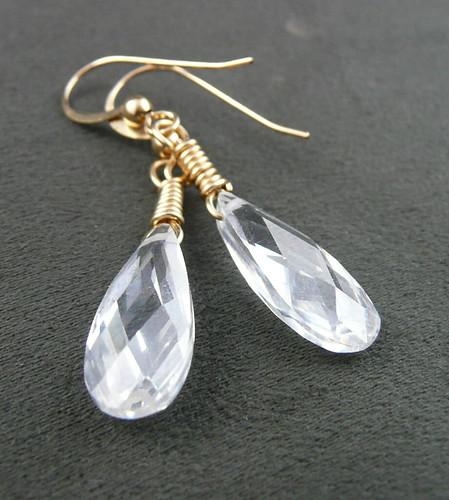 Do those really look like diamonds? Or are they simply beautiful earrings that deserve appreciation on their own?
Do those really look like diamonds? Or are they simply beautiful earrings that deserve appreciation on their own?Fake is one of those slightly subjective terms..."she's so fake." But how can something be fake if it is just representing itself? Cubic Zirconia isn't "fake" anything...it's Cubic Zirconia. Yes, it is a simulated, man made, material ... but that does not classify it as fake in my book. To me, just because a 'stone' is grown in a lab does not automatically make it "fake" (my mom disagrees with me, but I take my view from my grandmother who was a wonderful rock hound).
I have some gorgeous CZs and think they make lovely earrings and pendants.
 The great thing with CZ is that it costs a fraction of what natural gemstones would cost in the same shapes and sizes. Those Amethyst CZ briolettes above would cost me a fortune, but with CZ I'm able to create a gorgeous look at a much more reasonable price. Since my goal with these earrings is fun and flirty I don't need the natural stones. Sometimes I do want to go with the "real" (again, a subjective term to me) thing, but not always.
The great thing with CZ is that it costs a fraction of what natural gemstones would cost in the same shapes and sizes. Those Amethyst CZ briolettes above would cost me a fortune, but with CZ I'm able to create a gorgeous look at a much more reasonable price. Since my goal with these earrings is fun and flirty I don't need the natural stones. Sometimes I do want to go with the "real" (again, a subjective term to me) thing, but not always.Now, trying to pass CZ off as a diamond is wrong and fraudulent. If you are unsure as to whether a stone is CZ or diamond (like in a ring or earrings or something) there are just a few ways you can tell without using a microscope or chemicals.
- CZ weighs a lot more than diamond. 1.7 times more according to Wikipedia.
- Also, if the 'stone' you're looking at is absolutely colorless but is selling for a low price, it's probably a CZ. Only the very best, and rarest, diamonds are truly colorless. Most have some sort of inclusions or color to them. A "cheap" colorless diamond doesn't exist.
- If the 'stone' is set into sterling silver or a less expensive plated metal it is highly unlikely to be a diamond...while I might combine sterling or fine silver with diamond, most people don't bother. Diamonds generally go with gold or platinum.
- And the cut of a stone might tell you whether it's diamond or CZ...although if you're anything like me you can't really tell the difference with the naked eye. CZs are often cut using different facets than are used with diamonds.

1 comment:
I totally agree and these are beautiful earrings.
Post a Comment